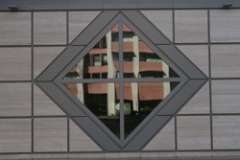A Hospital Built to Withstand Natural Disasters
Although natural disasters shook UCLA Medical Center in the past, its new medical facility is built to withstand the unexpected.

Ronald Reagan UCLA Medical Center was built in response to the damage incurred by the old hospital structure during the 1994 Northridge earthquake. The new hospital, which replaces the 1955 facility, is one of the first hospitals in the state to meet the latest California seismic safety standards. This state-of-the-art building will serve as a pillar of strength to the local community, even during those times when acts of nature test the community.
Architects designed the building to withstand a greater than 8.0 Richter Magnitude earthquake with no significant structural failures and no elements of the exterior cladding falling off the building. In addition, the hospital will remain fully operational, independent of outside resources, for the crucial 72 hours following a major earthquake. Basic performance standards require the building to withstand winds of 70mph and driving rain conditions.
Uniquely sized and shaped steel beams, weighing 20 to 25 tons each, provide the framework to ensure the hospital's ability to withstand seismic forces of the intensities that have rattled Los Angeles over the last century. Each beam measures 20 feet long by four feet deep with four-inch thick flanges. The steel columns encasing these beams measure two-feet square and weigh more than 900 pounds per foot. Engineers physically tested the structural design at the University of Nevada, Reno, one of just three sites in the United States capable of handling a task of this magnitude.
In total, the new building is made with 26,000 tons of steel - more than 17 times the amount found in the average office building. To meet the demands of an aggressive building schedule, the steel was fabricated in five different plants - three in California, one in Arizona and one in Thailand. Each large-scale weld required about 20 hours to complete - double the time of a standard weld.

The outer stone panels which sheathe the building also help make it safer in the event of an earthquake. They are designed to move as much as three feet, enough to keep the building safe during a large tremor. Made of Ambralight travertine marble, these 18,000 panels, each one tested for brittleness and shrinkage, help make the building unique in both form and function. The marble used to make the revolutionary exterior of the building was provided at a below-market-rate by Carlo Mariotti, a former patient of the UCLA Medical Center who wished to express his gratitude after his 12 years of treatments for both bone and gall bladder cancer.
The Federal Emergency Management Agency contributed $432 million in earthquake relief toward the rebuilding project and the State of California provided $44 million. Private donors contributed nearly $300 million, including a $150 million gift pledged in Ronald Reagan's honor by a group of prominent civic and cultural leaders. The remainder came from hospital financing and bonds. With the extensive preparation that has gone into building Ronald Reagan UCLA Medical Center, this facility is one of the strongest buildings in California - setting a new benchmark for earthquake safety.
Videos
Time-Lapse Construction of Ronald Reagan UCLA Medical Center (0:53)
Moving Day: June 29, 2008
Hundreds of patients are successfully moved from the old UCLA Medical Center to the new Ronald Reagan UCLA Medical Center.
Media Cover Patient Move to Ronald Reagan UCLA Medical Center
- KABC-TV: New Ronald Reagan UCLA Medical Center Opens
- LA Times: UCLA Medical Center Preps for its Biggest Operation: Moving Day
- LA Times: UCLA Medical Center Makes its Move
- Jewish Journal: UCLA's New Hospital Takes Technology to New Frontiers
- LA Times: Foreign Diplomats get a Firsthand Look at Los Angeles
- Dedication Day Program (pdf)